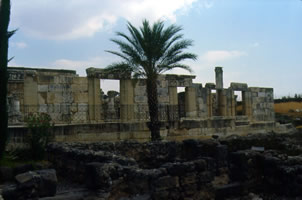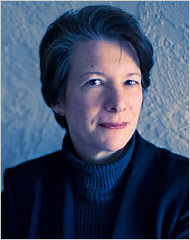 |
|
|
|
| Class
Prep |
|
|
|
Women
in Jesus' Teachings: Did He Liberate Them?
 Today, we will discuss the relationship of the gospels to one another,
noting the similarities and differences between them. In particular, we will observe
that the first three gospels are remarkably similar, and so have been labeled
the "Synoptic Gospels" because they see the story of Jesus through the
"same eye." These three gospels, Matthew, Mark and Luke, are so similar
to one another that they must have a literary relationship. We think that the likely direction of the copying was from Mark to Matthew and Luke; that is, Mark's gospel was first,
and Matthew and Luke borrowed from him. The thesis of Markan priority explains
the places where Matthew and Luke preserve a story that's also found in Mark.
Today, we will discuss the relationship of the gospels to one another,
noting the similarities and differences between them. In particular, we will observe
that the first three gospels are remarkably similar, and so have been labeled
the "Synoptic Gospels" because they see the story of Jesus through the
"same eye." These three gospels, Matthew, Mark and Luke, are so similar
to one another that they must have a literary relationship. We think that the likely direction of the copying was from Mark to Matthew and Luke; that is, Mark's gospel was first,
and Matthew and Luke borrowed from him. The thesis of Markan priority explains
the places where Matthew and Luke preserve a story that's also found in Mark. -
- But there are other places where
Matthew and Luke are similar and Mark does not exist. Almost all of these are
sayings of Jesus. This phenomenon led Hermann Christian Weisse to conclude in
1838 that a separate "source" (in German, "Quelle"
or "Q") lay behind these parallels. He further argued that Q was one
of the earliest elements of the written tradition about Jesus. Thus, if we want
to reconstruct the historical Jesus, Q is the closest written material to him.
Discovering Q was thus the literary equivalent of an archaeological excavation:
you are trying to get underneath later buildings (like the fourth-century synagogue
in Capernaum above) to the buildings of the Jesus era underneath (the black basalt
foundations in the foreground).
-
- Today's readings focus in on
women in the Q tradition. Begin with the one-page handout of six Q
passages available here (the same passages are available in in CG;
the handout just puts them all in one place). Either print out the handout and
bring it to class, or be sure to bring your copy of The Complete Gospels
to class. Then read Amy-Jill Levine's essay in WCO for the following issues:
-
- Why do some feminists believe Q is promising
ground for reconstructing an egalitarian Jesus movement? How does Luise Schottroff
read Q, and particularly the teachings in Q that pair male and female examples?
Levine disagrees; be able to explain why.
- Levine presents two different
reconstructions of the literary strata of Q, one by John Kloppenborg and one by
Dale Allison. What are they, roughly, and why do they matter for the reconstruction
of gender in early Christianity?
- Did the historical Jesus movement
include women? Is this evidence that Jesus sought to liberate women?
-
- Today you'll be ranking your choices for your dig site paper and presentation. Consider the ultimate topic you'll want to cover in your research paper, and then look over the options for the project on the handout distributed in class last week, to see which might most closely align with your contemporary issue. Come to class prepared to rank order at least your top ten choices.
-
-
- Assigned Readings
-
- Primary: Q 13:18-21; 17:34-35;
7:35; 10:21-22; 14:26-27 + 17:33; 18:14 (Note: Q designations follow Luke's chapters and verses; you'll find Q in CG pp. 253-300, or you can use this online synopsis of all six Q passages)
-
- Secondary: WCO 150-70 (Camino and textbook); online class prep
-
- Slides for Lecture
-
-
- Today's Author
-
| |
 |
Amy-Jill
Levine,
Carpenter Professor of New Testament Studies and Director, Carpenter Program in
Religion, Gender and Sexuality, Vanderbilt University |
-
-
- Further Reading
-
- Arnal, William E. "Gendered Couplets in Q and Legal Formulations:
From Rhetoric to Social History." Journal of Biblical Literature
116 (1997) 75-94.
-
- Batten, Alicia. "More Queries for Q: Women and Christian Origins." Biblical
Theology Bulletin 24 (2 1994) 44-51.
-
- Kloppenborg,
John S. The Formation of Q: Trajectories in Ancient Wisdom Collections. Philadelphia:
Fortress, 1997.
-
- --------. Excavating
Q: The History and Setting of the Sayings Gospel. Minneapolis:
Fortress, 2000.
-
- Robinson, James M., Paul Hoffmann and John S. Kloppenborg, eds. The
Critical Edition of Q, Hermeneia. Minneapolis: Fortress, 2000.
-
- Schottroff, Luise. "Itinerant Prophetesses:
A Feminist Analysis of the Sayings Source Q." In The Gospel
behind the Gospels: Current Studies on Q (ed. Roland A. Piper; NovTSup 75;
Leiden: E. J. Brill, 1995) 347-60.
-
- Tuckett, Christopher M. "Feminine Wisdom in Q?" In
Women in the Biblical Tradition (ed. George J. Brooke; Studies in Women
and Religion 31; Lewiston, New York: Edwin Mellen, 1992) 112-28.
-
-
- Links
-
- A
Synopsis for Q - A synopsis of the Matthean and Lukan sayings thought
to derive from Q, compiled by Peter Kirby using Young's Literal Translation.
- The Noncanonical
Home Page - Online access to all the so-called "hidden books" ("apocrypha")
of the Old and New Testaments, hosted by the Wesley Center for Applied Theology.
- The
International Q Project - Hosted by the Institute for Antiquity and Christianity
at the Claremont Graduate University, Claremont, California.
-
-
- Sources
-
- Photograph of synagogue: C. Murphy, "Façade of Capernaum
synagogue, ca.375+ CE, (O-259, July 1994).
-
- Photograph
of Levine: Daniel Dubois, from Julie Glambush, "Interfaith Approach to
Forgiving Trespass," New York Times online, Books (1 January 2007),
online, http://www.nytimes.com/2007/01/01/books/01gala.html.
|
|
|
|
|
|
|
